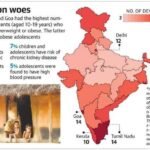Amla candy rescues Assam nutrition drive:Poshan Abhiyaan

For good nutrition among pregnant women and children in a southern Assam district administration has been given a gooseberry candy twist.The tablets(iron-folic acid tablets) given to these groups are often not consumed as they feel nauseated or have constipation issues. There are also myths that these tablets will kill them or make them incapable of conceiving.
To get around the problem while launching Poshan Maah, or nutrition month the district administration decided to produce roundish amla-gur candies with a dose of salt. Nutritionists involved in the campaign said amla, or gooseberry, is rich in Vitamin C and antioxidants, while gur, or jaggery, is rich in iron, vital vitamins and minerals that boost the immune system.
POSHAN ABHIYAAN
The Prime Minister’s Overarching Scheme for Holistic Nutrition or POSHAN Abhiyaan or National Nutrition Mission, is Government of India’s flagship programme to improve nutritional outcomes for children, pregnant women and lactating mothers. Launched by the Prime Minister on the occasion of the International Women’s Day on 8 March, 2018 from Jhunjhunu in Rajasthan, the POSHAN Abhiyaan directs the attention of the country towards the problem of malnutrition and address it in a mission-mode.to ensure attainment of malnutrition free India by 2022.by ensuring convergence of various nutrition related schemes.
- It targets stunting, under-nutrition, anaemia (among young children, women and adolescent girls) and low birth rate.
- It will monitor and review implementation of all such schemes and utilize existing structural arrangements of line ministries wherever available.
- These are key Nutrition strategies and interventions IYCF (Infant and Young child feeding), Food and Nutrition, Immunization, Institutional Delivery, WASH (Water, Sanitation and Hygiene), De-worming, ORS-Zinc, Food Fortification, Dietary Diversification, Adolescent Nutrition, Maternal Health and Nutrition, ECD (Early childhood development)/ECCE (Early Childhood care and Education), Convergence, ICT-RTM (Information and Communication. Technology enabled Real Time Monitoring) and Capacity Building etc.
LEARNING WITH TIMES
For several decades India was dealing with only one form of malnutrition– undernutrition. In the last decade, now faces the double burden which includes both over- and undernutrition,
What is malnutrition?
Malnutrition is the condition that develops when the body does not get the right amount of the vitamins, minerals, and other nutrients it needs to maintain healthy tissues and organ function. The term malnutrition covers 2 broad groups of conditions.
One is ‘undernutrition’—which includes stunting (low height for age;It is is associated with an underdeveloped brain, poor learning capacity, and increased nutrition-related diseases.), wasting (low weight for height;It is associated with decreased fat mass. Also known as wasting syndrome, it causes muscle and fat tissue to waste away.), underweight (low weight for age) and micronutrient deficiencies or insufficiencies (a lack of important vitamins and minerals).
The other is overweight, obesity and diet-related noncommunicable diseases (such as heart disease, stroke, diabetes and cancer).
Children who are already undernourished can suffer from protein-energy malnutrition (PEM).
Two types of PEM are— Kwashiorkor and Marasmus.






0 Comments